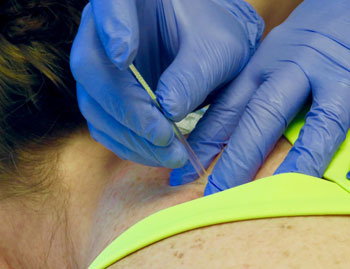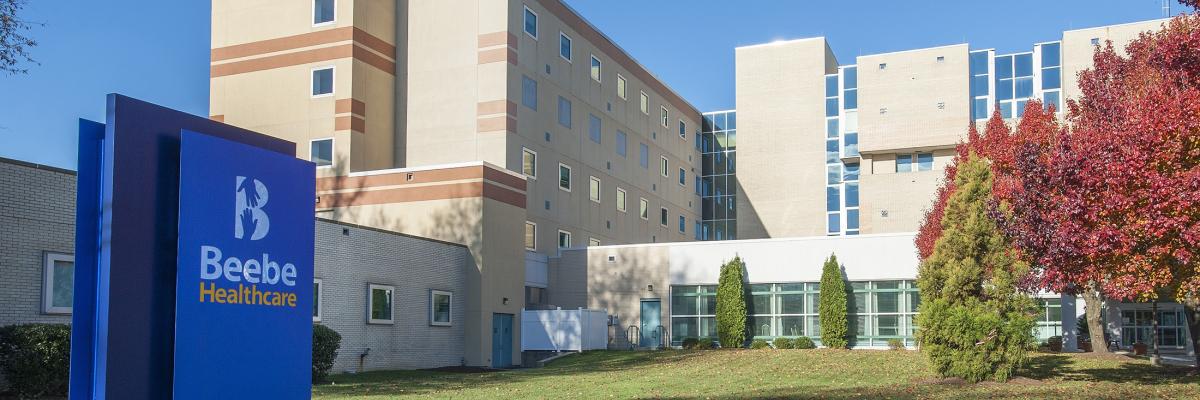Dry Needling as a Non-Opioid Alternative to Reduce Pain
 Millions of Americans suffer from acute and chronic pain. Beebe’s Physical Rehabilitation department is taking steps to find treatments that can offer patients relief without opioid medication.
Millions of Americans suffer from acute and chronic pain. Beebe’s Physical Rehabilitation department is taking steps to find treatments that can offer patients relief without opioid medication.
When pain attacks, often symptoms can be localized to a specific location or can radiate outward and affect distant parts of the body. This pain can last for weeks, and become frustratingly difficult to treat.
There are now four physical therapists in the Beebe Healthcare network who have recently completed board-approved training programs for employing the techniques of dry needling to help manage this pain and disability.
Dry needling is a treatment approach where thin needles are specifically placed into muscles for the purpose of relief. It is called “dry” needling because nothing is injected into the skin; the therapy consists of the needles themselves.
Dry needling is often mistaken for acupuncture, a traditional form of Chinese medicine. Dry needling uses the same needles as acupuncture, but this is where the similarity ends.
Instead of being founded on the principles of traditional Chinese medicine, such as how a vital energy force called “Chi” travels along pathways called meridians, dry needling calls upon our modern knowledge of anatomy and physiology to effect change in how the body moves.
If you’re wondering whether dry needling might be part of the answer for you, listed below are answers to some of the most common questions regarding the practice.
What pain does it treat?
One of the most common causes of pain treated by dry needling is called “myofascial pain.” Despite its name, it has nothing to do with the face — “myo” refers to muscles and “fascial” refers to a flexible substance called “fascia.”
Fascia wraps organs, muscles and just about everything else in our bodies in a stretchy, protective covering. Fascia is connected like a web throughout the body, so a problem in one area can generate pain in another. We use this interconnectedness to understand how compensation, weakness and poor movement patterns create further pain and disability.
Once irritated, this pain often manifests itself in irritable spots in the fascia called “trigger points.” These trigger points can be felt by touch, as the body often responds with a twitch when they’re compressed. It is believed that these trigger points are often the result of trauma to the body, whether that damage is muscular, skeletal or neurological in nature.
After a thorough evaluation of your neuromuscular and skeletal systems, the needle is used as an extension of our hands to help reduce the source of soreness and tissue dysfunction. Although the “trigger point” is often a component of the treatment, the trigger point itself is often a result of nerve-related dysfunction. Our nerves supply information throughout our entire body and drive us to be able to move and not suffer from pain. It is through this assessment that we can often successfully address the painful trigger point along with the root of the problem.
A recent study this year in January in the Archives of Physical Medicine and Rehabilitation examined 11 randomized controlled trials about the effectiveness of dry needling in relieving lower back pain and concluded that there is a “moderate quality of evidence recommending dry needling over other treatments” to relieve lower back pain.
We’re still learning about the ways in which structures in our bodies can be responsible for pain, and through this discovery finding better opportunities to treat it.
Does it hurt?
Even if it’s done to reduce long-term pain, it’s natural to wonder how much it will hurt to have needles inserted into your muscles. Part of our dry needling training involves ways to limit pain and avoid hitting vulnerable nerves.
That said, patients often say that, while they usually don’t feel the fine needle when it enters the skin, there can be some discomfort when the needle is working its way into the trigger point.
At the end, though, a more common sensation is relief, as a knot is finally resolved and more normal movement is achieved. The sensation varies person to person and varies immensely on the location of pain. The extremities are often more sensitive due to the higher density of nerve endings and sensitive structures.
A larger effort
Dry needling can be effective for treating pain associated with trigger points, but cannot prevent them. To do that, our team works with patients on creating healthy movement to prevent trigger points and other pain. The key to resolving the pain associated with trigger points is by finding and addressing the weakness and restricted movement that created the original strain. If this is not addressed, the trigger points will likely persist. As with most issues, there are no silver bullets or quick fixes, however, this manual method of resolving the pain associated with movement can expedite the recovery process.
When an injury leads to persisting pain, consider seeing a physical therapist who can work with you to build a plan that targets your pain at its root. This new service at Beebe allows us to holistically restore healthy pain-free movement and help you be your best.
To learn more about Beebe's Physical Rehabilitation Services, call (302) 645-3933 or visit www.beebehealthcare.org/beebe-rehab-services.
To find out how Beebe Healthcare is creating the next generation of care for the community, go to www.nextgenerationofcare.org.
